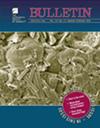Gravitational collapse of a volcano edifice as a trigger for explosive carbonatite eruption?
IF 3.9
1区 地球科学
Q1 GEOSCIENCES, MULTIDISCIPLINARY
引用次数: 0
Abstract
The Miocene Kaiserstuhl volcanic complex in the Rhine graben rift is known for simultaneously exposing both intrusive and erupted (pyroclastic) calciocarbonatites. This makes Kaiserstuhl a promising candidate for studying the field and genetic relations between intrusive calciocarbonatite and its eruptive equivalent, and the processes enabling eruption of the calciocarbonatite at the surface in particular. Eruptive calciocarbonatites in Kaiserstuhl are represented by carbonatite tuff and lapillistone beds covering a debrite fan on the western flank of the volcano. The debrites are interpreted as lahar (debris flow) and possibly also debris-avalanche deposits. Based on the observed textures, the debris flows were most likely derived by water dilution from debris avalanches resulting from edifice failure, which occurred in the central part of the Kaiserstuhl volcanic complex. The edifice failure ultimately exposed the intrusive system, and the carbonatite pyroclasts (lapilli and ash) were ejected from narrow vents represented by open-framework tuff-breccias aligned along the detachment scarp. Since the Ca-carbonates break down rapidly at high temperatures and low pressures, calciocarbonatites are unlikely to form surface lavas. On the other hand, the presence of the calciocarbonatite pyroclastic deposits suggests that some geological process faster than the high-temperature breakdown of Ca-carbonate may facilitate calciocarbonatite eruption. We suggest that the sudden exposure and decompression of a suprasolidus high-level carbonatite intrusion by edifice collapse may be a suitable scenario enabling calciocarbonatite eruption. The absence of edifice failures on alkaline volcanoes, where carbonatite intrusion is either supposed or exposed, may explain the overall scarcity of erupted calciocarbonatites.火山大厦的重力坍塌会引发爆炸性的碳酸盐岩喷发?
中新世Kaiserstuhl火山杂岩位于莱茵地堑裂谷中,以同时暴露侵入和喷发(火山碎屑)碳酸钙岩而闻名。这使得Kaiserstuhl成为研究侵入性碳酸钙岩及其喷发等效物之间的场和成因关系,特别是地表碳酸钙岩喷发过程的有希望的候选者。Kaiserstuhl火山喷发的钙碳酸盐以覆盖火山西侧碎屑扇的碳酸盐凝灰岩和宝石层为代表。这些碎屑被解释为泥流(泥石流),也可能是碎屑雪崩沉积。根据观察到的结构,泥石流很可能是由发生在凯泽斯图尔火山复合体中部的大厦坍塌导致的碎片雪崩造成的水稀释而产生的。构造破坏最终暴露了侵入体系,碳酸盐岩火山碎屑(石粒和灰岩)从沿滑脱陡崖排列的开格架凝灰岩角砾岩为代表的狭窄喷口喷出。由于碳酸钙在高温和低压下迅速分解,碳酸钙不太可能形成表面熔岩。另一方面,碳酸钙火山碎屑沉积的存在表明,某些比碳酸钙高温分解更快的地质过程可能促进碳酸钙火山喷发。我们认为,由大厦崩塌引起的超固体高水平碳酸盐岩侵入的突然暴露和减压可能是钙碳酸盐岩喷发的合适情景。在假定或暴露了碳酸盐岩侵入的碱性火山上,没有出现大厦坍塌,这可能解释了爆发的钙碳酸盐岩的总体稀缺。
本文章由计算机程序翻译,如有差异,请以英文原文为准。
求助全文
约1分钟内获得全文
求助全文
来源期刊

Geological Society of America Bulletin
地学-地球科学综合
CiteScore
9.30
自引率
8.20%
发文量
159
审稿时长
4-8 weeks
期刊介绍:
The GSA Bulletin is the Society''s premier scholarly journal, published continuously since 1890. Its first editor was William John (WJ) McGee, who was responsible for establishing much of its original style and format. Fully refereed, each bimonthly issue includes 16-20 papers focusing on the most definitive, timely, and classic-style research in all earth-science disciplines. The Bulletin welcomes most contributions that are data-rich, mature studies of broad interest (i.e., of interest to more than one sub-discipline of earth science) and of lasting, archival quality. These include (but are not limited to) studies related to tectonics, structural geology, geochemistry, geophysics, hydrogeology, marine geology, paleoclimatology, planetary geology, quaternary geology/geomorphology, sedimentary geology, stratigraphy, and volcanology. The journal is committed to further developing both the scope of its content and its international profile so that it publishes the most current earth science research that will be of wide interest to geoscientists.
 求助内容:
求助内容: 应助结果提醒方式:
应助结果提醒方式:


